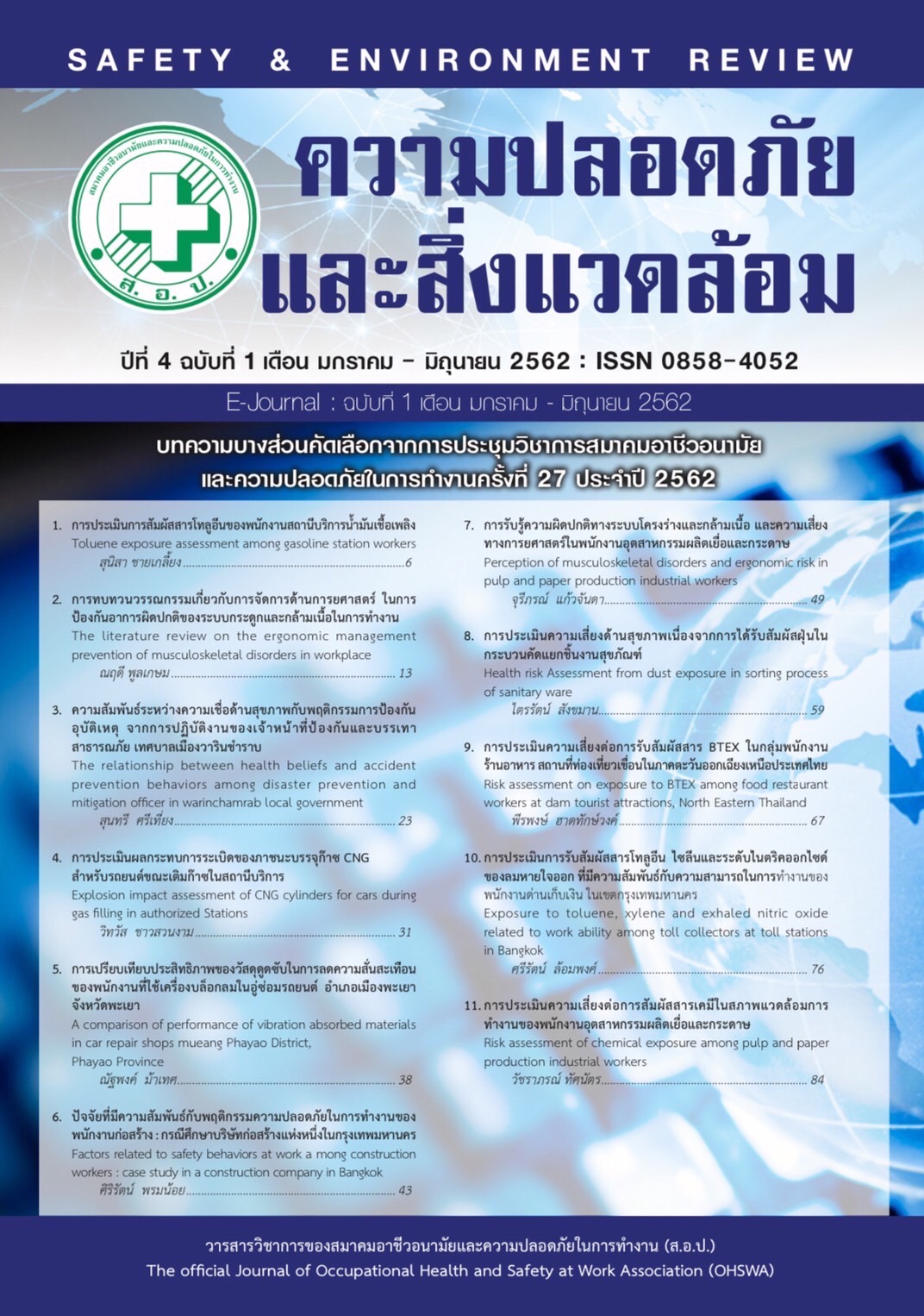Risk assessment onexposure to BTEX among food restaurant workers at dam tourist attractions, North Eastern Thailand
Keywords:
BTEX, Benzene, Health risk assessment, Air pollution, kitchenAbstract
Indoor air pollution is important health problem that causeshealthimpact to several part. The cooking process could
emit air pollutant to the indoor air especially, commercial cooking. This study aimed to study the concentration level of
benzene, toluene, ethylbenzene, and xylene (BTEX) in the kitchen atmosphere and to assess the health risk due to expose
BTEX among food restaurant workers at the sevendam restaurants of tourist attractions. The result showed that symptoms
related to respiratory system werestuffy nose(60.66%), nasal irritation (41.02%), and nasal mucous34.44%. The average
concentration level of BTEX that food restaurant workers exposed through working time were0.0081, 0.0068, 0.0068
and0.0146 mg/m3,respectively. The results from human health risk assessment in long-term (Hazard Index; HI > 1) showed
that chefs had health risk (HI) between 0.043to0.138. Assistant chefs had health riskbetween0.043 to0.077. Waitresshad HI 0.013-0.035andcashiers had Hi0.013-0.035. So, all work positionshad acceptable risk (HI<1). The calculated health risk assessment
on cancerfrom benzene exposurewasbetween 9.33 x 10-11to4.38 x 10-9 (acceptable value,IUR:2.2 x 10-6) and from
ethylbenzene exposure was between2.21 x 10-9to2.33 x 10-8 (IUR: 2.5 x 10-6). Although all position had acceptable risk from
BTEX exposure, some workers had respiratory symptoms related to polluted chemicals emitted from the cooking process
in kitchen that several researches confirmed of those substances could be carcinogens such as polycyclic aromatic
hydrocarbon (PAHs).So that, the related department of dam shall provide safety training for the food restaurant workers
in order to motivate them to aware of health hazards and protection in parallel with providing annual health surveillance
and workplace monitoring.
References
กระทรวงสาธารณสุข. คู่มือการปฏิบัติงานเพื่อการตรวจ ประเมินคุณภาพอากาศในอาคาร. พิมพ์ครั้งที่ 1. นนทบุรี: สำนักอนามัย สิ่งแวดล้อม กรมอนามัย กระทรวงสาธารณสุข; 2559.
Masih A, Lall AS, Taneja A, Singhvi R. Exposure profiles, seasonal variation and health risk assessment of BTEX in indoor air of homes at different microenvironments of a terai province of northern India. Chemosphere. 2017;176:8–17.
Chen L, Hu G, Fan R, Lv Y, Dai Y, Xu Z. Association of PAHs and BTEX exposure with lung function and respira¬tory symptoms among a nonoccupational population near the coal chemical industry in Northern China. Environment International. 2018;120:480–8.
Huang Y, Ho SSH, Ho KF, Lee SC, Yu JZ, Louie PKK. Characteristics and health impacts of VOCs and carbonyls associated with residential cooking activities in Hong Kong. Journal of Hazardous Materials. 2011;186:344–51.
ศศิธร เรืองตระกูล, ทรรศนีย์ พฤกษาสิทธิ์, เดซี่ หมอกน้อย. การประเมินความเสี่ยงจากการสัมผัสสารบีเทคผ่านทางการหายใจของ พนักงานเก็บค่าผ่านทางพิเศษ ในเขตกรุงเทพมหานคร. วารสารการ จัดการสิ่งแวดล้อม. 2556;9:1–22.
Pak VM, Powers M, Liu J. Occupational chemical exposures among cosmetologists: risk of reproductive disor¬ders. Workplace Health & Safety. 2013;61:522–9.
Liu Q, Liu Y, Zhang M. Personal exposure and source characteristics of carbonyl compounds and BTEXs within homes in Beijing, China. Building and Environment. 2013;61:210–16.
สุนิสา ชายเกลี้ยง. พิษวิทยาสาธารณสุข. พิมพ์ครั้งที่ 1. ขอนแก่น: โรงพิมพ์มหาวิทยาลัยขอนแก่น; 2557.
World Health Organization. Exposure to benzene: a major public health concern [Internet]. Available from: https://www.who.int/ipcs/features/benzene.pdf. Cited: De¬cember 12, 2018.
กรรณิการ์ ฉัตรสันติประภา. พิษวิทยาของสารเคมีทาง อุตสาหกรรม Toxicology of industrial chemicals. พิมพ์ครั้งที่ 1. ขอนแก่น: โรงพิมพ์มหาวิทยาลัยขอนแก่น; 2552.
Luttrell WE, Peterson HR. Ethylbenzene. Journal of Chemical Health and Safety. 2011;18:41–42.
ศรีรัตน์ ล้อมพงศ์. การประเมินการรับสัมผัสสารโทลูอีนและ รูปแบบการใช้ชีวิตของพนักงานเก็บกวาดขยะของสำนักงานเขตแห่ง หนึ่งในเขตกรุงเทพมหานคร. วารสารสาธารณสุขมหาวิทยาลัยบูรพา. 2561;13:29–37.
Duan W, Meng F, Wang F, Liu Q. Environmental behavior and eco-toxicity of xylene in aquatic environments: A review. Ecotoxicology and Environmental Safety. 2017;145:324–32
วิวัฒน์ เอกบูรณะวัฒน์, สุทธิพัฒน์ วงศ์วิทย์วิโชติม, บรรณาธิการ. พิษวิทยาอาชีพ. พิมพ์ครั้งที่ 1. ชลบุรี: มูลนิธิสัมมาอาชีว; 2554.
Kanjanasiranont N, Prueksasit T, Morknoy D. Inhalation exposure and health risk levels to BTEX and carbonyl compounds of traffic policeman working in the inner city of Bangkok, Thailand. Atmospheric Environment. 2017;152:111–20.
NIOSH. NIOSH Manual of Analytical Methods (NMAM) [Internet]. Available from: https://www.cdc.gov/
niosh/docs/2003-154/pdfs/1501.pdf. Cited: December 13,2018.
Environmental Protection Agency. Risk Assessment Guidance for Superfund. [Internet]. Available from: https:// www.epa.gov/risk/risk-assessment-guidance-super¬fund-rags-part-f. Cited: February 2,2018.
U.S. Environmental Protection Agency. Integrated Risk Information System (IRIS) Chemical Assessment Sum¬mary [Internet]. Available from: https://cfpub.epa.gov/ ncea/iris/iris_documents/documents/subst/0276_summary.pdf#nameddest=cancerinhal. Cited: February 2,2018.
Integrated Risk Information System (IRIS). Benzene [Internet]. Available from: https://cfpub.epa.gov/ncea/iris/iris_documents/documents/subst/0276_summary.pd-f#nameddest=rfc. Cited: February 2,2018.
Integrated Risk Information System (IRIS). Toluene [Internet]. Available at: ttps://cfpub.epa.gov/ncea/iris/iris_documents/documents/subst/0118_summary.pdf#named-dest=rfc. February 2,2018.
Integrated Risk Information System (IRIS). Ethyl¬benzene [Internet]. Available from: https://cfpub.epa.gov/ncea/iris/iris_documents/documents/subst/0051_summary. pdf#nameddest=rfc. Cited: December 2,2018.
Integrated Risk Information System (IRIS). Xylenes [Internet]. Available from: https://cfpub.epa.gov/ncea/iris/iris_documents/documents/subst/0270_summary.pd-f#nameddest=rfc. Cited: December 2,2018.
Deepti S, Suresh J. Impact of intervention of bio¬mass cookstove technologies and kitchen characteristics on indoor air quality and human exposure in rural settings of India. Environment International. 2019; 123:240–55.
ธนสร ตันศฤงฆาร, สุนทร ศุภพงษ์, วีนัส อุดมประเสริฐกุล, อนุสรณ์ รังสิโยธิน, กัลยา ซาพวง, เริง ศักดิ์ บุณบรรดาชัย และคณะ. การศึกษาเบื้องต้นของผลกระทบต่อ BTEX และ MTEX ต่อสุขภาพ พนักงานสถานบริการน้ำมันเชื้อเพลิง. วารสารวิจัยวิทยาศาสตร์การ แพทย์. 2547;8:117–34
Guo H, Lee S., Li W., Cao J. Source characterization of BTEX in indoor microenvironments in Hong Kong. Atmo¬spheric Environment. 2003;37:73–82.
เกษศิรินทร์ เอี่ยมโพธิ์. การประเมินความเสี่ยงต่อสุขภาพ จากการได้รับสัมผัสสารกลุ่ม BTEX จากเครื่องถ่ายเอกสาร. วารสาร วิชาการ Veridian E-J บัณฑิตวิทยาลัย มหาวิทยาลัยศิลปากร. 2557;1:1–6.
สุนิสา ชายเกลี้ยง, สายชล แปรงกระโทก. การประเมินความ เสี่ยงต่อการสัมผัสสารเบนซีนผ่านทางการหายใจในสถานีบริการน้ำมัน เชื้อเพลิง. วารสารพิษวิทยาไทย, 2558; 30:48–60.
นพนันท์ นานคงแนบ, พรพิมล กองทิพย์, มัตติกา ยงประเดิม, ดุสิต สุจิรารัตน์. การประเมินความเสี่ยงด้านสุขภาพจาก การรับสัมผัสสารอินทรีย์ระเหยง่ายของพนักงานร้านถ่ายเอกสารบาง แห่งในกรุงเทพมหานคร. วารสารสาธารณสุขศาสตร์. 2558; 45:90– 103.
Kuo-Pin Yu, KeRuo Yang, Yen Chi Chen, Jia You Gong, Yen Ping Chen. Indoor air pollution from gas cooking in five Taiwanese families. Build. Environment. 2015;.57: 258–66
Downloads
Published
Issue
Section
License

This work is licensed under a Creative Commons Attribution-NonCommercial-NoDerivatives 4.0 International License.
This article is published under a Creative Commons Attribution-NonCommercial-NoDerivatives 4.0 International License (CC BY-NC-ND 4.0), which allows others to share the article with proper attribution to the authors and prohibits commercial use or modification. For any other reuse or republication, permission from the journal and the authors is required.



